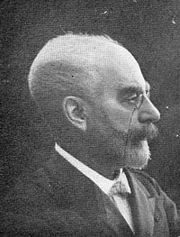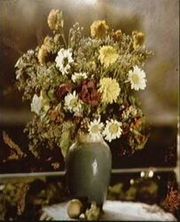Gabriel Lippmann
| Gabriel Lippmann | |
|---|---|
 |
|
| Born | 16 August 1845 Bonnevoie, Luxembourg |
| Died | 13 July 1921 (aged 75) SS France, Atlantic Ocean |
| Nationality | France |
| Fields | Physics |
| Institutions | Sorbonne |
| Alma mater | École Normale |
| Known for | Photochromy Lippmann plate Lippmann electrometer |
| Notable awards | Nobel Prize for Physics (1908) |
Jonas Ferdinand Gabriel Lippmann[1] (16 August 1845 – 13 July 1921) was a Franco-Luxembourgish physicist and inventor, and Nobel laureate in physics for his method of reproducing colours photographically based on the phenomenon of interference, later known as the Lippmann plate.
Contents |
Biography
Lippmann was born to Franco-Jewish parents in Bonnevoie (former commune of Hollerich),[2] Luxembourg. When Gabriel was three, his family moved back to France, to live in Paris, where he was homeschooled.[3] Lippmann studied in Heidelberg, received his doctorate in philosophy in 1873, went to Paris in 1875, where he continued to study until 1878, when he became professor of physics at the Sorbonne[4]. (See also the extensive biography on the The Nobel Prize in Physics 1908 page[5]).
He is remembered as the inventor of a method for reproducing colors in photography, based on the interference phenomenon, which gained him the Nobel Prize for Physics for 1908[6]. He was one of the founders of the Institut d'optique théorique et appliquée in France. He also invented an electrometer that was used in the first ECG machine. In 1908, he devised integral imaging.
Lippmann was a member of the Academy of Sciences from 8 February 1886 until his death, including serving as its President in 1912.[7] In addition to that, he was a Foreign Member of the Royal Society of London, a member of the Bureau des Longitudes,[3] and a member of the Grand Ducal Institute.
Lippmann married the daughter of novelist Victor Cherbuliez in 1888.[3] He died on 13 July 1921 aboard the steamer France while en route from Canada.[8]

Literature
- J.P. Pier & J.A. Massard (eds) (1997):Gabriel Lippmann: Commémoration par la section des sciences naturelles, physiques et mathématiques de l’Institut grand-ducal de Luxembourg du 150e anniversaire du savant né au Luxembourg, lauréat du prix Nobel en 1908. Luxembourg, Section des sciences naturelles, physiques et mathématiques de l’Institut grand-ducal de Luxembourg en collaboration avec le Séminaire de mathématique et le Séminaire d’histoire des sciences et de la médecine du centre universitaire de Luxembourg, 139 p.
References
- ↑ Birth certificate, cf. R. Grégorius (1984): Gabriel Lippmann. Notice biographique. In: Inauguration d'une plaque à la mémoire de Gabriel Lippmann par le Centre culturel et d'éducation populaire de Bonnevoie et la Section des sciences de l'Institut grand-ducal. Bonnevoie, le 13 avril 1984: 8-20.
- ↑ Cf. p. 82: J.A. Massard (1997): Gabriel Lippmann et le Luxembourg. In J.P. Pier & J.A. Massard (éds): Gabriel Lippmann: Commémoration par la section des sciences naturelles, physiques et mathématiques de l’Institut grand-ducal de Luxembourg du 150e anniversaire du savant né au Luxembourg, lauréat du prix Nobel en 1908. Luxembourg, Section des sciences naturelles, physiques et mathématiques de l’Institut grand-ducal de Luxembourg en collaboration avec le Séminaire de mathématique et le Séminaire d’histoire des sciences et de la médecine du centre universitaire de Luxembourg: 81-111.
- ↑ 3.0 3.1 3.2 "Gabriel Lippmann". Nobel Foundation. http://nobelprize.org/nobel_prizes/physics/laureates/1908/lippmann-bio.html. Retrieved 2007-02-12.
- ↑ Eder, J.M (1945) [1932]. History of Photography, 4th. edition [Geschichte der Photographie]. New York: Dover Publications, Inc.. p. 668. ISBN 0486235866.
- ↑ From Nobel Lectures, Physics 1901-1921, Elsevier Publishing Company, Amsterdam, 1967
- ↑ From Nobel Lectures, Physics 1901-1921, Elsevier Publishing Company, Amsterdam, 1967
- ↑ "Les Membres de l'Académie des sciences depuis sa création (en 1666)" (in French). Académie des sciences. http://www.academie-sciences.fr/membres/in_memoriam/in_memoriam_liste_alphabetique_L.htm. Retrieved 2008-03-01.
- ↑ Gabriel Lippman, Scientist, Dies at Sea. The New York Times,14 July 1921.
External links
- Nobel Foundation
- Gabriel Lippmann in Jewish Encyclopedia
- Centre de Recherche Public - Gabriel Lippmann
|
||||||||||||||||||||